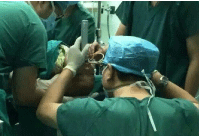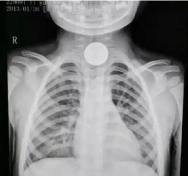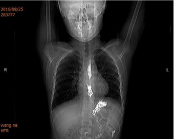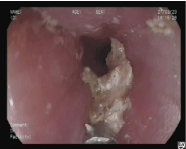Research Article
China View of the Management of Esophageal Foreign Bodies
Jiang Chang1* and Zhen Zhao2
1Department of ENT, Dongguan Children’s Hospital, China
2Department of ENT -Head and Neck, Fourth Hospital of Hebei Medical University, China
*Corresponding author: Jiang Chang, Division of Pediatric ENT, Dongguan children’s Hospital, Guangzhou, Guangdong Province, China
Published: 07 Dec, 2016
Cite this article as: Chang J, Zhao Z. China View of the
Management of Esophageal Foreign
Bodies. Clin Surg. 2016; 1: 1221.
Abstract
Which way to remove foreign bodies in children is best way has been the subject of much controversy over the years. N Western, South America (such as Brazil) and many other countries.
Objective: To apply Foley catheter guided in the removal of esophageal foreign bodies of children.
Method: 12 cases of esophageal foreign bodies were removed by Foley catheter, 1 case the foreign
body of proximal gastric junction were taken down to the stomach and discharged through the
digestive tract.
Results: In these group 13 cases, 12 cases were one-time removal, 1 cases foreign body by the anus
automatic discharge. No complications were reported in this group.
Conclusion: For children with esophageal foreign body, application of Foley catheter guided
combined with anesthesia for esophageal foreign body with smooth edges, simple equipment, easy
operation, little pain, low cost, and lack of equipment basic hospital. Foreign body in the lower part
of the esophagus, some children can be pushed into the stomach by endoscopic and then eliminated
by the natural digestive tract.
Keywords: Foreign bodies; Children; Foley catheter
Introduction
Which way to remove foreign bodies in children is best way has been the subject of much
controversy over the years [1]. Non-endoscopic methods such as a Foley catheter technique have a
lot of advantages, such as their simplicity and cost savings, particularly for proximally located coins.
Especially in China, many hospitals have also applied this method, not applied the appropriate
anesthesia. Now considering the children age, psychology, ethics, and other aspects of children, for
our technician was improved, our teams apply the Foley catheter technique with induced anesthesia
method, which achieved without pain and fear saving the time of the operation. However, their
complications can be potentially serious regarding airway obstruction or perforation (Figure 1 and
2).
Materials and Methods
Case Data
There were 13 cases in this group, 9 males and 4 females, aged from 3 to 10 years old, the time
of onset was from 30min to 24h, and the foreign body was located in the first stenosis of the upper
esophagus. Foreign bodies were metal coins in 9 cases, plastic coins in 2 cases, 1 cases of screw cap.
1case the foreign body of proximal gastric junction --bone. All diagnosed by chest radiography. All
of the foreign bodies were coins, currency and other game disc. All in the first stenosis of esophagus.
All patients are children.
Operation Steps
After induction of anesthesia, no need to intubation, take the supine position, Assistant to hold
the head in order to protect the neck, Use of the anesthetic laryngoscope Foley catheter inserted
thrans-oral to esophagus, the balloon catheter to Foley foreign body below about 2cm, 2ml normal
saline injection to the balloon, and then gently pull out the catheter Foley, there will be a little
resistance to uniform force, with foreign body filling water bag out of the esophagus. 1case foreign
body was taken down to the stomach by endoscopy and discharged through the digestive tract.
Note for surgical operation
From the entrance for esophageal foreign body, because the
sphincter contraction and Foley catheter elastic, the foreign body can
play to oral nasal or trachea, carefully check can be found. Prevent
foreign bodies from falling into the trachea [2].
Postoperative treatment
24h successfully removed, after the operation can be into the cold
liquid, after 24h removed into liquid 1-2d, without antibiotics.
Figure 1
Figure 2
Figure 3
Figure 4
Results
In this group 5 cases, 4 cases were one-time removal, 1 cases foreign body by the anus automatic discharge. No complications were reported in this group. All patients were discharged on the first day after surgery.
Discussion
Foley catheter guided has a lot of advantages, such as their simplicity and cost savings, particularly for proximally located coins. However, their complications can be potentially serious regarding airway obstruction or perforation. For many developed countries, more general anesthesia is applied to this method. And we use induction anesthesia, anesthesia time is short, can achieve the same effect. The foreign body shape is complete, as far as possible smooth, foreign body in vivo time is short for good, for sharp foreign body does not apply (Figure 3 and 4).
Conclusion
For children esophageal foreign body, application of Foley
catheter guided combined with induced anesthesia for esophageal
foreign body with smooth edges, simple equipment, easy operation,
little pain, low cost, and lack of equipment basic hospital. Foreign
body in the lower part of the esophagus, some children can be pushed
into the stomach by endoscopic and then eliminated by the natural
digestive tract.
For many like our medical conditions, medical institutions lack
of equipment, we can use the above method, especially the Foley
catheter, its advantage is not only fast, simple operation, low cost, and
avoid the patients may therefore have psychological shadow and fear
and pain.
References
- Aurora Burgos, Luis Rábago, Paloma Triana. Western view of the management of gastroesophageal foreign bodies. World J Gastrointest Endosc. 2016; 8: 378-384.
- Ikenberry SO, Jue TL, Anderson MA, Appalaneni V, Banerjee S, Ben- Menachem T, et al. Management of ingested foreign bodies and food impactions. Gastrointest Endosc. 2011; 73: 1085-1091.




